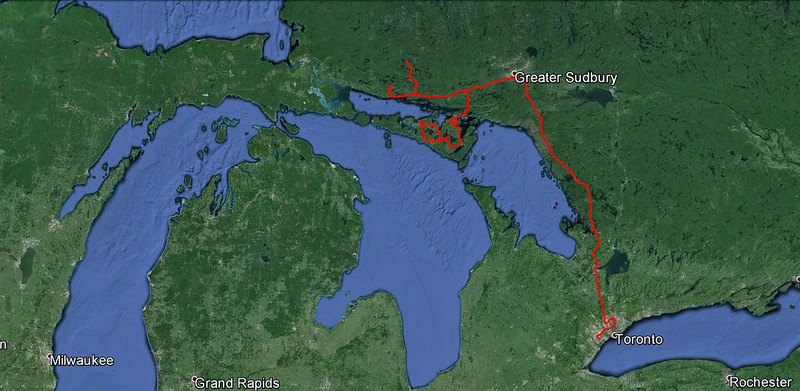 |
| Our route from Toronto, to Chutes and Matinenda Provincial Parks, to Elliot Lake & Missisagi Provincial Park, then to Manitoulin Island, Oastler Lake Park and back to Toronto |
During our trips over the past 5
years, we have visited almost every provincial park or region located
relatively close to Toronto (up to 5 hours of driving) which are suitable for
camping and especially canoeing and many a times have returned to the same
place more than once. Not that we were
running out of locations to visit: Ontario has
thousands of lakes or rivers to explore and canoe on, yet many of them are
located quite far from Toronto,
are only accessible by tough 4x4 Utility Vehicles or by planes, are quite
remote and often require plenty of extensive and arduous portages. Yet the good Lord, or rather the Ontario Government (or, even more
precisely, the Ontario Ministry of Natural Resources) works in mysterious ways:
after examining a map of Ontario, I spotted a rather new park called Matinenda
Provincial Park, located 15 kilometers north of the town of Blind River. This park, 29,417 hectares in size, was
established 10 years ago (in 2003) and it offers such recreational activities
as fishing, hunting, cottaging, camping, boating, canoeing, hiking,
snowmobiling and swimming. Since currently
there are no developed camping facilities within the park (only unmanaged
campsites), no fees of any kind are required. There are numerous lakes in the park, Matinenda Lake being the largest. I also contacted Ontario Parks
and received a few emails from Ms. Tamara Flannigan, Park Superintendent, Missisagi
& Spanish River Provincial Park Cluster.
Without doubt, the park appeared quite attractive & secluded; since
Catherine never visited that area, we decided to visit it.
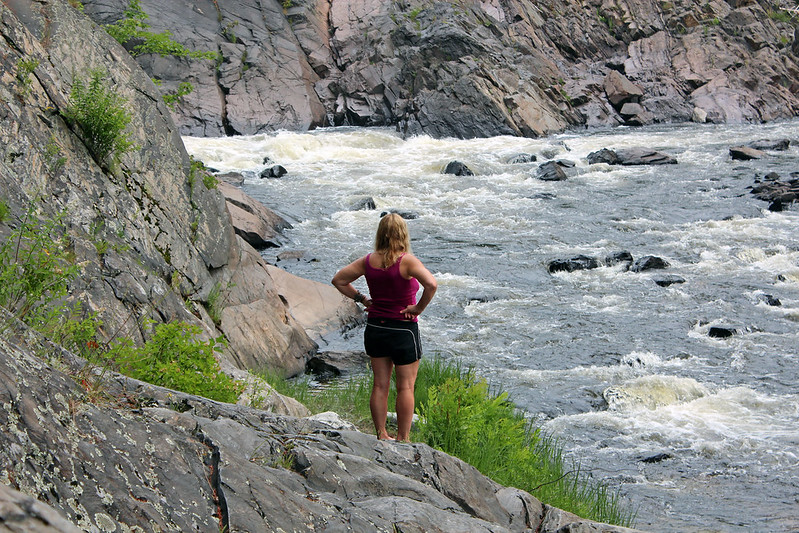 |
| At Chutes Provincial Park, near the waterfall |
We left Toronto on July 15, 2013 and headed north on
highway 400. It was a very hot and humid
day and we stopped a few times to rest, did some shopping in Parry Sound,
stopped for coffee & gas outside Sudbury and arrived to a small town of
Massey, from where we drove a few kilometres to Chutes Provincial Park where we
were going to camp overnight, as driving to Matinenda in one day and then
paddling to a campsite would have been too exhausting.
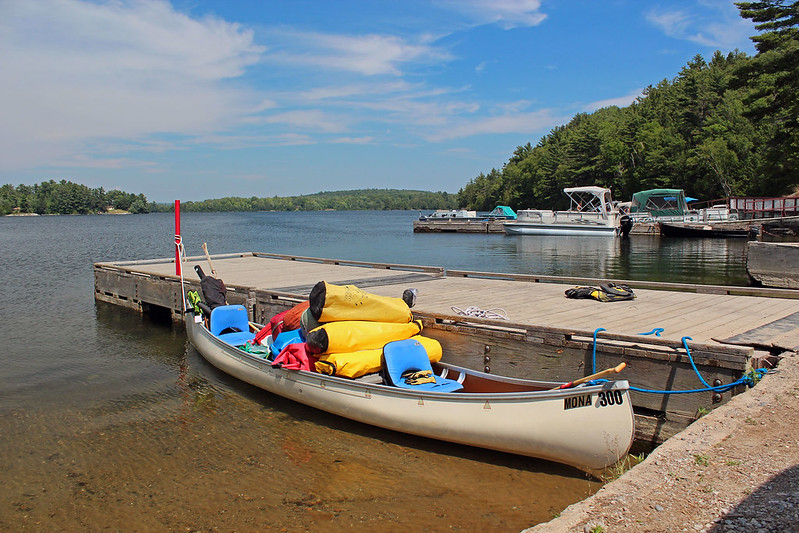 |
| Departing from the Matinenda Lake Parking Lot |
Chutes gets its name from a log
chute that once diverted logs around the main waterfall during the days of
river drives and horse logging. As per
the park staff recommendation, we chose campsite no. 95, just across from the scenic
rapids and waterfalls and we were very happy.
Half hour later the campsite beside us was taken. There was at least one hiking trail, but we
only had time to walk down a long staircase to see the falls. By the time we got the fire going and
grilling our T-Bone steaks, the mosquitoes were in full attack, biting us horribly. We could hardly enjoy the dinner and the cold
beer and quickly retired to the tent, soon falling sleep, listening to the
soothing sound of the waterfalls.
In the morning we packed up and
drove to LCBO in town to buy cold beer; while parking close to the LCBO
building, Catherine almost hit the wall of the building with the canoe on the
roof and for some unexplained reasons was very upset when I pointed this out to
her. After driving around the town, we took highway 17, stopped in the town of
Blind River
at KFC (
Tuesday’s Toonie Special!)
and tried to find the road leading to Matinenda. We asked a local guy how to get to the park,
but he said he had never heard of it, but finally found another fellow who gave
us good directions. After driving on
road 557 for less than 30 minutes, we reached its end, with a huge, busy and
free parking lot. There were cars (and
boats) coming and going; while unloading the canoe, I chatted with a few people
who had cottages on the lake. Funny, but
they learned from me that it was a provincial park!
 |
| Canoeing on Lake Matinenda towards Graveyard Island |
We departed at 15:30, as always
grabbing onlookers’ and other boaters’ attention due to our above-average
number of bulky bags piling up in our canoe (we told them we were going for a
few months). I had no clue where we were
going to camp, yet according to the map the area near
Graveyard
Island, on
Lake Matinenda,
appeared to be quite appealing. Thus, we
proceeded north, moving quite leisurely in the hot and sticky weather. We kept close to the shore on our left and
after an hour a large bay opened up on the left. We were quite tired and instead of continuing
to paddle north, towards
Graveyard
Island, we decided to
explore the bay and possibly find a spot suitable for a campsite. Indeed, Catherine soon caught sight of a prospective
campsite on the shore, but I did not like it and insisted on paddling farther
into the bay.
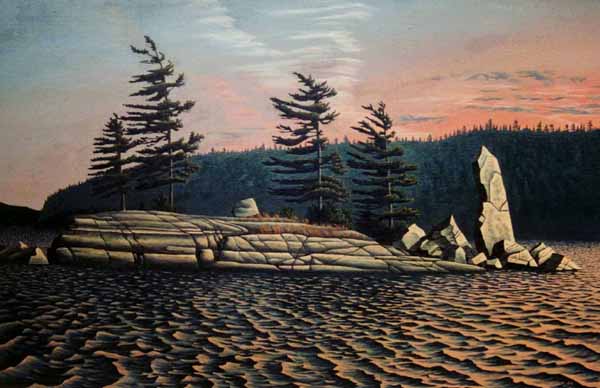 |
Monument Island on Lake Matinenda by Dave Moir. Yes, we were lucky to camp on this island for several days! Reproduced by permission. This image may be purchased from the author at http://www.viewcanada.com |
There were two islands in
front of us; the one on the right was probably private, but no structure was
visible on the other one. When we
reached that island, we immediately fell in love with it: it was round and
rocky, approximately 100 x 60 meters, with some tall pine trees and plenty of blueberry
bushes. Its center was mostly flat and barren
rock, where an old fire pit was built.
Yet the most amazing characteristic of this island was a massive, vertical
rock sculpture, which looked like a giant gun, it remained us of the Monolith from
the movie “2001: A Space Odyssey” (all we needed was a tribe of shrieking and
jumping man-apes and I could have made an alternate beginning of this celebrated
movie!). Only when I looked at my GPS’
topographical map, I realized that the name of this tiny island was, very
fittingly “
Monument Island”.
 |
| Finally we arrived at Monument Island! |
We left most of our kitchen
equipment along the rocky shore, several meters from the rocky monument, set up
the tent nearby and continued using the existing fire pit. A few times we saw motorboats and fishing
boats, but otherwise no one disturbed our privacy. That first night a rather peculiar phenomenon
took place. I was lying down in my tent,
and since there was no wind and everything was so still and quiet, I was slowly
drifting off. Suddenly, I heard a very
distinct sound of waves crashing against the island’s shores, as if a motorboat
had just passed by and created such waves — however, I was certain I did not
hear any boat! The reverberations lasted
for about a minute and they ceased as abruptly as they had begun.
 |
| The fire pit and our tent on Monument Island |
On July 18, 2013, we paddled to
south-west of the island, where the bay became narrow, meandering and
eventually turned into the
Blind
River. We hoped to get to another big lake,
Chiblow Lake.
We kept paddling until we reached a small dam; too lazy to portage, we
turned back. It was raining for a while,
but since it was hot, we did not mind getting a little wet. Once we left the ‘mouth’ of the river, we
were again on
Lake
Matinenda. It was noon; there was no wind and even the
birds hid in the forest, avoiding the heat and humidity. A log was sticking out of the water; we
paddled up to it. It was the end of a
much longer log submerged in the water.
As I pushed it, it slowly gave way... and then something quite remarkable
happened: all of a sudden, we heard a very conspicuous sound of running water,
as if a dam came open! Since this
mysterious noise started almost the instant I dislodged the tree log, I almost suspected
that I inadvertently unlocked some kind of plug or obstruction, thus causing
the release of the water from the lake.
 |
| Our campsite on Monument Island |
Both Catherine and I heard that sound and we were looking everywhere to
see the source of this clatter, but did not spot anything suspicious. Soon, it stopped and again nothing was
disturbing our sally. We paddled north,
leaving our island on the right, then passed a rocky island full of sea gulls
and cormorants. Some of the gulls became
quite agitated and swooped and dive-bombed up to scare us away — quite spooky! We paddled through
Butterfield Narrows — there were several cottages, forming a small cottage community — and saw
Graveyard Island as well as many other imposing rocky hills and rugged shores. From afar we saw the Winter Portage. We turned back, again passing through the narrows, near Paradise Point, marked with a white cross with the following inscription: “
Paradise Point. Lift up your eyes on HIGH, and BEHOLD who hath created these things. Isaiah 40:26”. On our way back we were again ‘attacked’ by some frantic birds, but once they realized we were going the other way, they ended their harassing us.
 |
Near the rocky island full of birds on Lake Matinenda.
The birds were trying to attack us! |
On July 18, 2013, as we were
having our supper around the fire, we saw that the weather was not looking very
promising — there were plenty of black, massive clouds, yet no rain and even some
fishermen in a small motor boat were circling our island, hoping to catch a
fish. I turned on my marine radio and
listened to the weather channel. There
was a weather alert, indicated by a sharp, piercing sound coming out of my
radio and we heard that a severe storm was on its way into the area, with gusts
of wind of almost 100 km/h. We hurriedly
finished our supper and secured the canoe and camping equipment along the shore. Less than 15 minutes later the first drops of
rain fell... and in no time a hell broke lose!
Although we were safely inside the tent, we could hear the pouring rain
and soon felt very strong wind which literally pushed one side of the tent’s
wall halfway inside the tent! We had no
idea if the tent would withstand such tensions. Before long, we heard thunder and saw such intense lighting that I was blinded by it, even though I was observing the lighting through the tent’s walls and fly! At one point the thunder and lighting occurred almost at the same time — I would not be surprised if the monolith had been struck by lighting! In spite of the rain, wind and lighting, I donned my rain gear and got out of the tent in order to check on the canoe and other stuff left on the shore. The canoe was OK, although partially in the water (of course, it was tied to a tree, as two years ago, while we were camping in the
Massasauga
Park, it had floated away)
and our barrels were also safe. The lake
resembled a miniature ocean: the water looked as though it was boiling, its
surface seething with white caps, fierce waves savagely battering the
shores. I shuddered, thinking what if we
had been caught in such a storm while canoeing!
The storm lasted for about one hour and I can honestly say that I do not
remember ever experiencing such a violent tempest while camping! The tent passed its test with flying colors;
not only did it hold out, but everything inside the tent also remained dry.
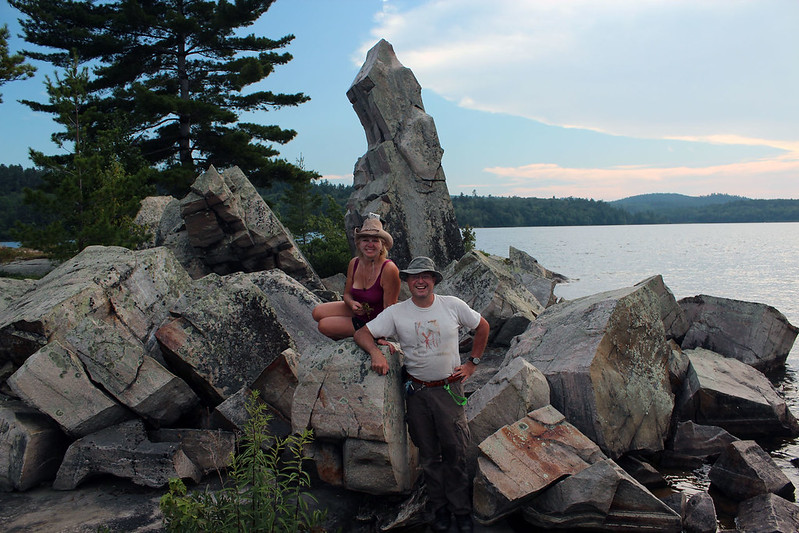 |
| Around the Monument on Monument Island! |
On Saturday we got up in the
morning and started packing. During our
stay on the island we noticed that there were plenty of cockroaches of various
sizes; most of them congregated either around the campfire or along the shore,
where we kept our kitchen equipment.
 |
| Monument Island at night |
While packing, Catherine suddenly screamed — as she took the knife out
of its sheath, four cockroaches dropped out!
We decided to carefully go through all of our belongings, to ensure we
were not going to bring any of them home!
We did find some bugs in the box as well as several in the base of the
stove; fortunately, none managed to get into our waterproof bags and
barrels. This cockroach inspection
delayed our departure by almost 2 hours, but we did not mind taking all those precautions;
afterwards, Catharine wanted to re-christen the island “The Cockroach Island”.
 |
| Our canoeing trips in Matinenda Provincial Park |
The paddle back to the parking
lot was nice and quick (7 km, 1.5 hours).
Since it was Saturday, there were many people, including a great deal of
Americans. A dog constantly barking
drove everybody crazy and caused me to pack the car in a record time. We drove to
Blind
River where we visited LCBO and the
Bargain Shop, then took highway 17 east and turned north into road 118, leading
to
Elliot Lake, thus ending the first part of
our trip.
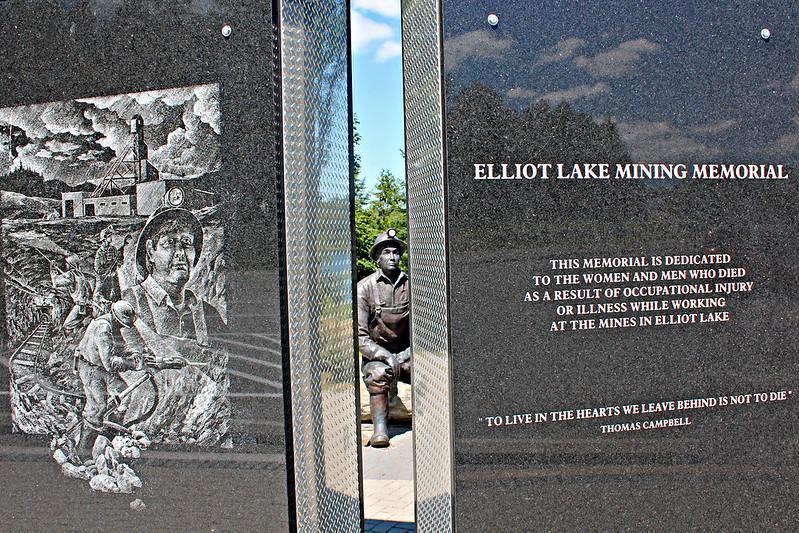 |
| Elliot Lake Mining Memorial |
Elliot Lake
was established as a planned community for the mining industry in 1955, after
the discovery of uranium in that area and at its peak the population reached
26,000, when the town was the world’s capital of uranium mining. In the 1990s the last uranium mine closed and
some predicted it would become a ghost town, one of many in
Ontario.
However, a lot of retired people started moving in, attracted by cheap
homes and the area’s beauty. Today, the
town has a hospital, malls, stores and even public transportation.
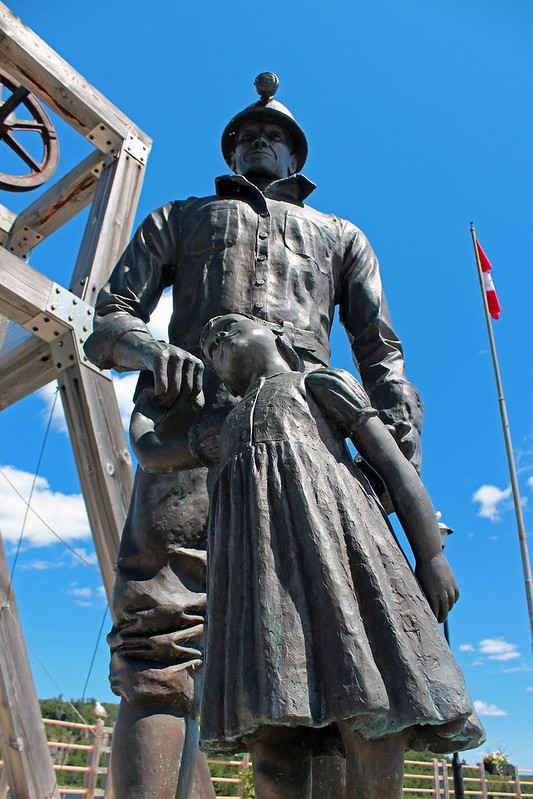 |
| Elliot Lake Mining Memorial |
I had visited this city for the
first time in 1993 and I still remember a tour that I was given by a real
estate salesmen. Townhouses were priced
from $20,000 to $30,000 and a house could be purchased for about $50,000! That was why a lot of retired people, after
selling their residences in Toronto for a substantial (and usually tax-free)
profit, moved to Elliot Lake where they lived from approximately May till
October and then drove to Florida and other southern states to spend the
winter.
In 2003 I spent a week camping with
a friend in the nearby Missisagi
Provincial Park,
located just north of the town. One day
morning my friend saw a small black bear near the campsite. Barefoot, I bolted out of the tent, jumped in
my car and started following the bear.
Eventually the car ended up in a ditch (and the poor, scared bear,
vanished in the forest). My friend Chris
flagged a passing car and asked the driver to take him to the park
superintendent office, who later came, attached a chain to my car and quickly
pulled it from the ditch. As I later
went to thank the lady-driver for helping us (she was camping not that far from
us), I realized that in 1995 she and I had participated in a canoeing trip in Florida’s Everglades and
I even had a photo with her in a restaurant, having fried... alligator! Because of her respiratory problems, she
needed fresh air and she camped in the park from May till October.
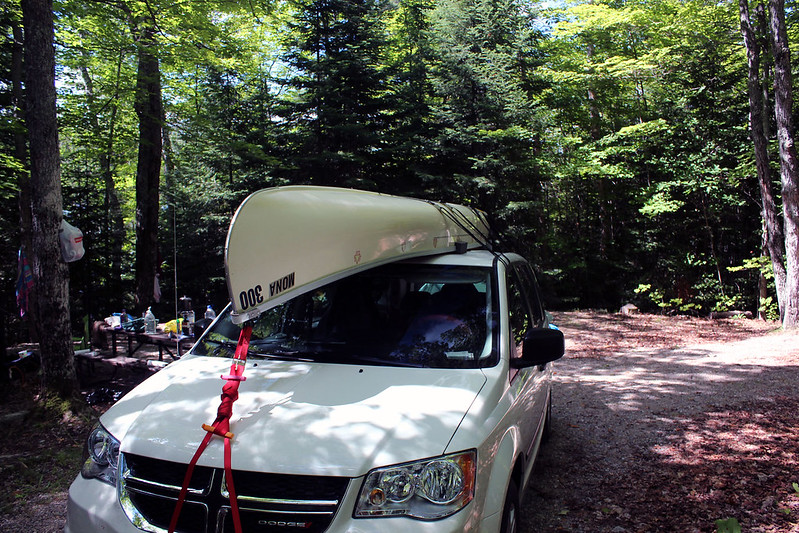 |
| Campsite no. 15 at Missisagi Provincial Park near Elliot Lake |
Since Catherine had never visited
this park, we decided to spent a night or so there. Missisagi Provincial Park was supposed to be changed
to non-operating status the Ontario government (along with 9 other parks), yet
the city of Elliot Lake managed to reach an agreement with the Ontario
government and in the 2013 season the park was still operational. I was surprised to find plenty of campers in
the park — something quite unusual for a park that supposedly did not have enough
visitors and was to be closed! Even
though we were planning to stay just one night in the park, we still wanted to
get a nice campsite and spent an hour, driving on meandering roads before
picking campsite no. 15. We set up the
tent and talked to the couple next door waling their dog, then to a guy camping
across from us and also to a family from
Switzerland that rented a Travel
America camper. Catherine went for a
walk and met an 80-something fellow who had had 2 hip replacements by a very
bad surgeon, he experienced plenty of problems.
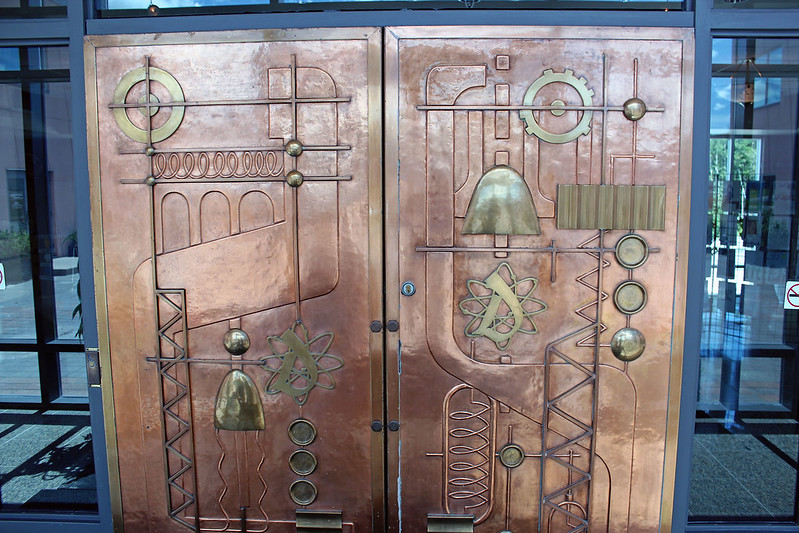 |
Door leading to the building where the Mining Museum
and the Canadian Mining Hall of Fame were
located. The door originally belonged to one of
the leading mining companies in the area |
Later that evening and the next day we drove back to town where
Catherine took a shower at the RV grounds and then we set out to explore the
town. I noticed a new mining monument,
erected along the lake. There was also a
granite wall that listed names of miners who succumbed to various work-related diseases
while working in the area’s mines. We visited the site of the Algo Centre Mall: in June, 2012, part of a roof
collapsed at Algo Centre Mall and two people were killed. Almost every day we could listen to the news
of the ongoing inquiry regarding this tragedy.
We also visited the
Mining Museum, located in the
Lester
B. Pearson
Civic Center,
which I found very interesting and informative, it showed the history of the
mining industry and there was the Canadian Mining Hall of Fame, showing photographs of many prominent individuals who
contributed to the mining industry in
Canada as well as plenty of other
historical artefacts. Pity we did not
have more time to explore this place!
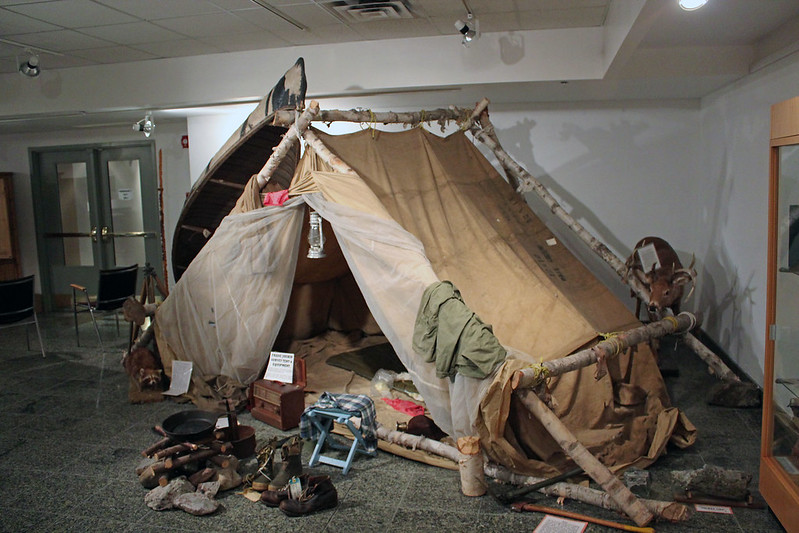 |
| W Muzeum Górnictwa w Elliot Lake |
One of the most prominent mining engineers responsible for the area’s
development was Stephen Boleslav Roman, a Slovak immigrant. In the 1980s he had an impressive Cathedral
of the Transfiguration in
Markham built (just
north of
Toronto). He died in 1988, before the Cathedral’s
completion, and his was the first funeral service held in the Cathedral. Unfortunately, due to various problems, the Cathedral
was closed in 2006 and is no longer considered to be a Catholic Church.
 |
| Our route on Manitoulin Island |
The next day we packed up and headed
towards
Manitoulin
Island. This island, with the area of 2,766 square km,
is the largest lake island in the world, as well as one of its 108 freshwater
lakes,
Lake Manitou, is the largest lake on a
freshwater island in the world! It is
possible to access the island via a one-lane Little Current swing bridge (which
used to be a railway bridge, but it has not seen a train in many decades) or,
in the summer, via a daily passenger-vehicle ferry, the MS Chi-Cheemaun
(meaning, in Ojibwe, “Big Canoe”), which travels between Tobermory on Bruce
Peninsula and South Baymouth on the island.
At the beginning of the season in 2013 the water level was too low for
the ferry to dock, so for the first few weeks it was unable to operate, thus
negatively affecting the local economy.
Some locals also complained that whereas the news about the inability of
the MS Chi-Cheemaun to run between Tobermory and Manitoulin Island was widely
publicized in the mass media, once the ferry commenced its operations, that
fact was not really advertised that much and thus many potential visitors to
the island incorrectly assumed the ferry was still grounded and decided to go
somewhere else.
 |
| Welcome to Little Current! |
A historical plaque at Swift
Current Channel provided some interesting information on the importance of this
channel in during past centuries, when many prominent people use this waterway:
THE ROUTE OF THE
VOYAGEURS
Through
this channel at Swift Current passed the canoes of the explorers, missionaries
and fur traders who opened up the interior of this continent. Their route
followed the Ottawa River to its junction with the Mattawa and thence via Lake
Nipissing, the French River, Georgian Bay and the North Channel to Lakes
Michigan or Superior.
This waterway was traversed by Jean Nicolet, 1634, Pierre Esprit Radisson and
Médart Chouart des Groseilliers, 1659, Father Claude Allouez, 1665, Daniel
Greysolon, Sieur Dulhut, 1678, Pierre de la Vérendrye, 1727, Alexander Henry,
1761, Simon McTavish and William McGillivray, 1784, David Thompson, 1812, and
Sir George Simpson, 1841.
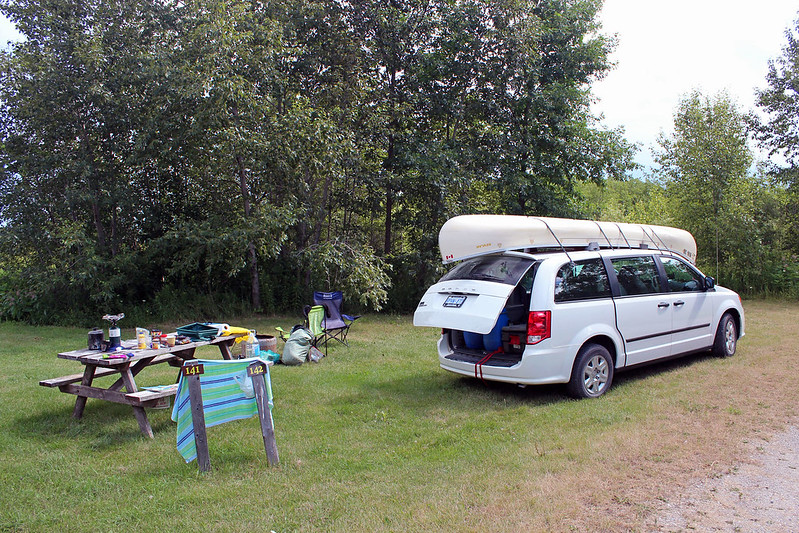 |
| Our campsite at Batman's Cottages and Campground |
After briefly stopping in
Espanola, we drove on the Little Current swing bridge and went to the Visitors’
Center, where we picked up some brochures on local accommodations and
attractions. Since almost 40% of
Manitoulin’s population consists of Native People, we were quite excited when
we found a brochure advertising a native campground and immediately headed
there. When we arrived, there were several
native campers, ceremonial grounds, open space and nobody in the office... we
did not really know where we could camp without committing any disrespect to
those sacred grounds and we decided to check out another place, called
Batman’s. I entered its coordinates in
my GPS unit and foolishly followed its directions. Wow, did it take us for a ride! We were driving on some dirt, potholed roads,
passing farmlands or pastures, hardly spotting a home or barn. We had to turn around twice as the road
became impassable for the van. At one
point we drove down a very steep hill — fortunately, the canoe was securely attached
to the van’s roof, otherwise it would have probably slid off! We saw numerous wind turbines popping up on
the horizon. I knew that GPS units were
not perfect, but I could not believe that they were so brainless!
 |
| (Probably) abandoned church |
Eventually we did get on the main road (which
we should have taken in the first place) and soon reached ‘Batman’s Cottages
and Campground’. There were plenty of semi-permanent
structures (
i.e., RV campers and
mobile homes), creating a small, dynamic community, as well as several
campsites. We picked campsite no. 142,
with a view of the lake. Well, after
camping on remote islands, pristine lakes and desolate shores, this place certainly
did not appeal to us, but since there were not any provincial parks on
Manitoulin Island, we had no choice but to stay
there for at least one night. I quickly
started a campfire and once it became dark, we enjoyed the stay, going to bed
before midnight. At about 4:00 am we
were awoken by some noise; Catherine got out of the tent and then quickly came
back, saying that there was not a bear, but an even worse creature at our
campsite: a skunk, who got into our garbage bag! We were very quiet, although it would be
extremely unlikely for a skunk to spray without any provocation. When we got up in the morning, it had been
gone and the only evidence of its earlier presence was a few pieces of
scattered garbage.
 |
| At the Kicking Mule Ranch, playing with kittens! |
Then we headed to a very remarkable
place called Gordon’s Park, near the town of
Tehkummahk. It offered camping, tipi tenting (which
especially appealed to Catherine!), stargazing cabin, wilderness campsite, educational
hiking trails, solar heated swimming pool and dark star preserve, among other attractions. The friendly staff showed us around and even
drove us several hundreds meters up the road, where the dark star preserve was
located, along with a few cabins. We
liked this place and thought it would be great to one day visit it with some
other couples and stay in a cabin, but since a very large group (75) of young
people were just about to arrive, we were afraid this place would become too
busy and noisy for us and decided to continue looking for another place; as per
Gordon’s Park employee recommendation, we drove a few kilometres up the road to
a place called “Kicking Mule Ranch”.
 |
| At the Kicking Mule Ranch, ponies |
We found a ranch with 4 tiny
campsites and 2 bunkers — in addition to a ranch full of horses & mules,
there was a petting zoo (with rabbits, chicken, goats and lama-like animals),
ponies, a very friendly Rottweiler which, as the sign warned, ‘may lick you to
death’ and four lovely kittens! We
picked a campsite next to a tepee and an antique Cadillac; except for occasional
horse riders, we were the only ones staying there overnight. For some reasons, it was a magical
place! The owner’s 8 year old grandson
came over to chat and later he was riding one of the ponies.
 |
| At the Kicking Mule Ranch |
We drove to the post office in Tehkummahk and
tried to find a public phone, but to no avail; eventually somebody let
Catherine use his cell phone so that she could call her daughter in the
US. We got back to the ranch around 6:00 pm and
nobody else was there. We walked to the
petting area, took a bunch of photos and played with the kitties, having so
much fun! Kitties kept trying to get in our
tent. Catherine let one sleep with her,
but took it back to his igloo house around 2:00 am. Big Rottweiler Diesel was jealous of the kitties
and eventually came over to our tent, looking for our attention! Of course, we also had a campfire.
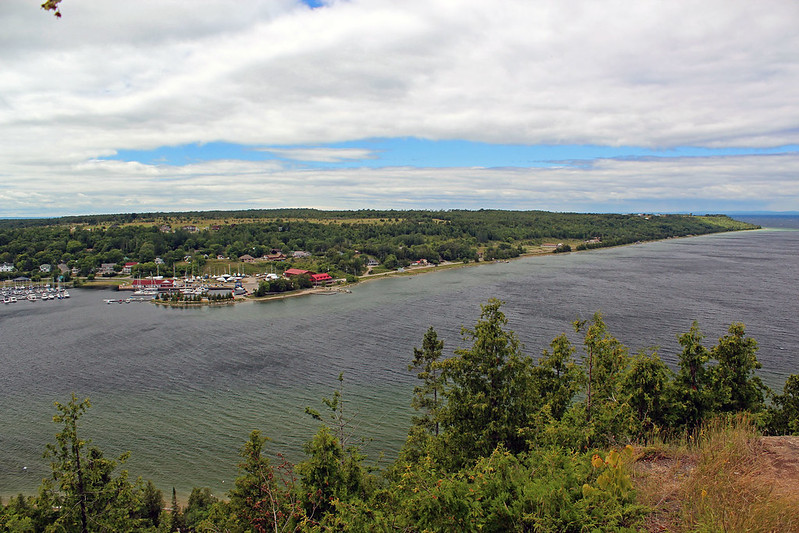 |
| Gore Bay |
Next day we drove across the
island. There were lots of lakes on
Manitoulin, many Indian reserves as well as the Wikwemikong Unceded Indian
Reserve. By the way, ten years ago I had
driven to Wikwemikong, where I visited a catholic church and the ruins of an
old, burned down church. Since I had
known the Jesuit pastor of this church, Father Doug McCarthy, I hoped to pay
him a brief visit, but he was away.
We
drove on road 542 and eventually reached
Gore Bay.
There was a lookout point from which we
could admire the whole bay and the town, watching boats slowly coming into the
bay and float planes landing and taking off.
It was quite windy, cool and rainy, yet we still drove to the Janet Head
Lighthouse and then back to the Kicking Mule Ranch on road no. 540. Fortunately, our campsite was dry, the bad
weather had not managed to get hold of it.
The next morning we packed up (accompanied by one inquisitive kitty who
was walking on the car and hiding under the canoe on the roof). Before we left, we talked to the owner of the
ranch, who took us to the corral and explained the difference between horses
and mules.
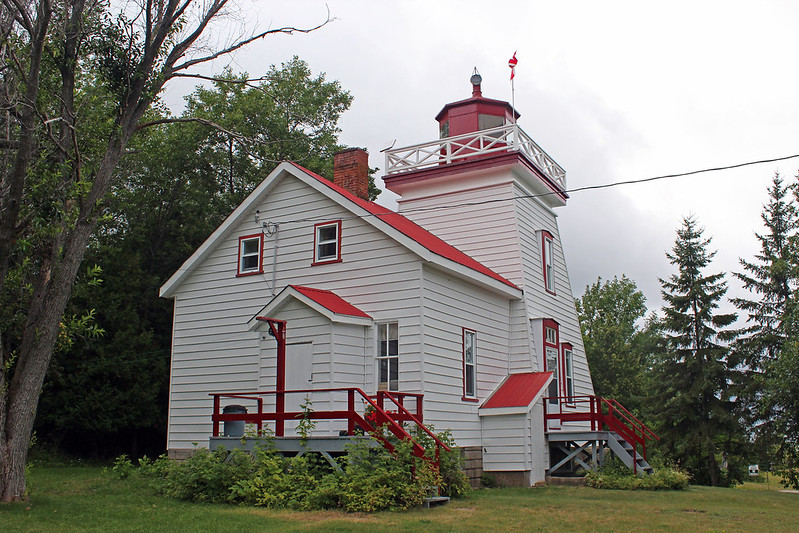 |
| Lighthouse near Gore Bay |
We drove back to Little Current,
where we looked at a Native Pow Wow site and a beautiful wooden church, with
amazing architecture. We also stopped at
10 Mile Point, from where a breathtaking view of Georgian Bay towards the town
of
Killarney stretched out; possibly I could
even see the
Fox Islands, where we had camped
in 2011 and 2012. There was a Trading
Post with plenty of very unique and interesting books, Native art, paintings, carvings
and original T-shirts. The following
historical plaque gave more details about the history of this area:
JESUIT MISSION TO MANITOULIN
1648 – 50
In
1648 Father Joseph Poncet, then serving at St. Marie in Huronia, was placed in
charge of the Jesuit mission of St.
Pierre by his superior Father Paul Ragueneau. This
newly created mission was formed to serve the Algonkian-speaking Indians of
Manitoulin Island and the north shore
of Lake Huron. Poncet,
the first known European resident of Manitoulin (called Ile de Ste. Marie by
the missionaries and Ekaentoton by the Hurons), served on this island from
October, 1648, to May, 1649. He returned to Manitoulin before the end of the
latter year, but was compelled to abandon the mission in 1650, following the
defeat and dispersal of the Hurons by the Iroquois.
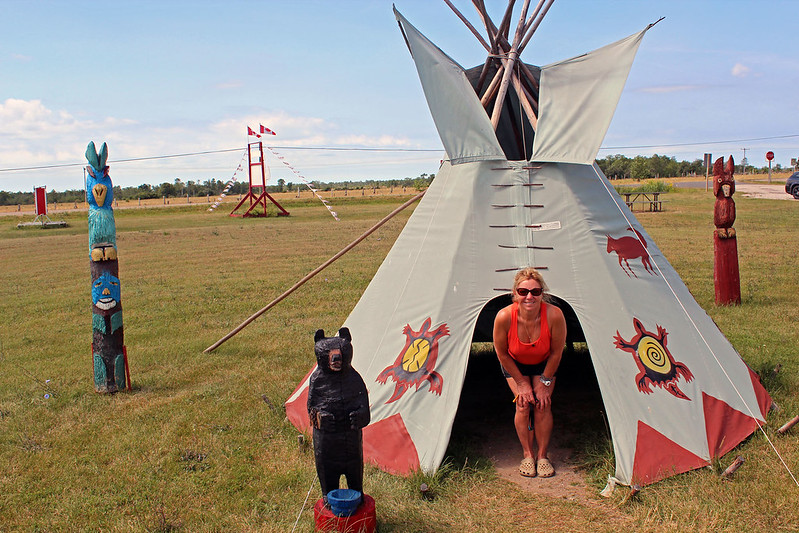 |
| At the 10 Mile Point Trading Post |
After parking the van in Little
Current, we walked along a waterfront, observing plenty of motorboats, cruisers
and sailing boats. We stroke up a conversation
with one gentleman from
Detroit
whose big cruiser was docked nearby. He
enthusiastically answered my questions about his impressive craft (which,
incidentally, was a new one, as the old one had perished in a marina fire in the
USA,
along with tens of other similar boats).
It turned out that the yacht could accommodate up to 12 people, it had
two 300 or 400 hp engines, was using enormous amount of gas, costing probably well
over $1 per kilometre, had all the latest electronic & GPS equipment so
that once programmed, it basically navigated itself. The more information I was finding out about
this boat, the more I was glad we had our simple, light, inexpensive, paddle-powered
and virtually maintenance-free canoe!
 |
| Dock in Little Current, Manitoulin Island |
Later we had a cup of coffee in a nearby coffee shop and then spent over
one hour in a discount shop which offered some amazing bargains! Finally we drove over the Little Current
bridge, thus officially leaving
Manitoulin
Island and stopped in a mall in Espanola,
where we did some shopping and cold beer, and drove all the way to Parry Sound,
where we arrived at
Oastler
Lake Provincial
Park. This is a nice park, just several km south of
Parry Sound. We had stayed a few times
at this park, mostly for one night, while going to or coming from our
vacation. We got a nice campsite (no.
132), facing west and after quickly setting up the tent, we could still sit
and, sipping cold beer, enjoy the sunset.
Next day we spend a few hours leisurely paddling on
Oastler Lake
and in the evening drove back home to
Toronto.




























Fantastic report, as usual. A liitle bit of terryfing moment (thundering, interesting places - Maespecially Manitoulin Island. Grretings.
ReplyDeleteThanks, Daniel. Yes, the storm was a very special experience, we were concerned about our tent, canoe and being struck by lighting, but we survived intact!
ReplyDeleteLike reading a good little book, gorgeous photography and descriptions of the area I have called home since late 60's--thank you!
ReplyDeleteG.Hansen
Elliot Lake
Hello,
DeleteThanks for your comments.
I'm sure that your description of the area's history would be even more fascinating!
Regards,
Jack